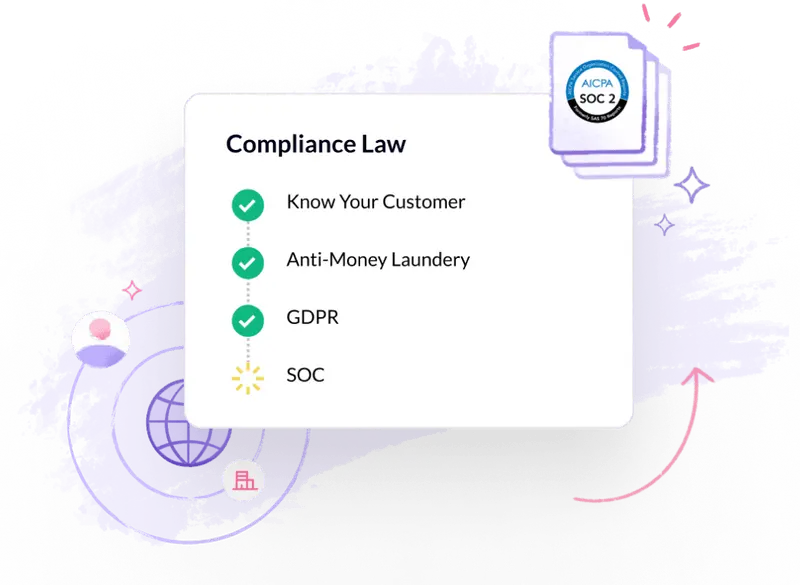AML and CFT fines comprised 99% of all penalties imposed on financial institutions last year. Authorities around the globe are tightening up on regulations – proving their commitment to combat money laundering. The question is, are businesses ready?
Money laundering is not a localized issue. It affects everyone around the world. Lately, governments and regulatory bodies have intensified efforts to combat this problem. AML laws have become stricter, and penalties are harsher as a result of this. While significant fines are one reason to fight money laundering, it is worth noting that AML compliance is much more than that – it protects businesses’ integrity, builds customer trust, and ensures long-term success.
Major AML fines in 2023
Here are some of the biggest AML fines levied in 2023
Binance
$4.3 billion in fines and restitution
Binance, one of the biggest cryptocurrency exchanges in the world, was hit with a $4.3 billion fine. The company had erred with serious issues. One of which was using the wrong wallet addresses. Then there was the issue of depositing tokens that didn’t match. Furthermore, there were problems with blockchain upgrades.
Casino operator Crown Resorts
AUD 450 million ($300 million) fine imposed
Crown Resorts is a well-known Australian casino operator. It got fined AUD 450 million ($300 million) for flouting AML laws. The hefty penalty resulted from the company not properly watching high-risk customers. This and a few more issues hurt Crown Resorts’ reputation and made people worry about how good their internal checks are. The fine is a clear reminder that it’s important to have strong AML practices in the gambling industry.
Deutsche Bank
The bank and its US affiliates were fined $186 million
Deutsche Bank and its US partners were fined $186 million for not fixing old anti-money laundering (AML) problems. Even though they were warned many times, the bank didn’t do enough to fix these issues, leading to big fines. This case shows how serious the consequences can be for ignoring AML rules. It also highlights the ongoing struggles banks face in keeping strong compliance systems. The fine shows how important it is to have active and effective AML measures to stop financial crimes.
Lessons learned from these cases are as follows:
- Companies that prioritize growth over compliance risk severe penalties. The right approach is to ensure vigorous anti-money laundering and KYC programs are in place and followed to stop illegal transactions and avoid fines.
- Focusing on profits instead of legal duties leads to serious consequences. Leaders must prioritize following regulations. This not only builds a culture of honesty but also avoids legal troubles.
- Weak internal controls and governance fail to stop money laundering. It’s essential to have effective internal controls and strong governance to follow AML rules.
- Not working with and being open with regulators makes problems worse. Regular engagement and transparency with regulators are key to ensuring compliance and addressing risks early.
- Poor monitoring of transactions lets suspicious activities go unnoticed. Financial institutions should invest in advanced monitoring systems to detect and report suspicious transactions continuously is vital.
- Poor third-party risk management causes indirect violations and penalties. Making sure all third-party partners follow AML regulations is necessary to avoid related risks and penalties.
Biggest AML fines in 2025 (so far)
Two Las Vegas casinos (MGM Grand, and Cosmopolitan)
Fine: A combined settlement of $7.45m
MGM Grand and the Cosmopolitan in Las Vegas were fined a total of $7.45 million for flouting AML laws. The casinos failed to meet key Bank Secrecy Act requirements. This let suspicious transactions from an illegal sports betting scheme go unnoticed. As they did not monitor and report these suspicious activities, illegal operations were able to continue.
Commerzbank
Fine: €1.45 million ($1.5 million)
Commerzbank was fined €1.45 million ($1.5 million) for serious gaps in its anti-money laundering controls. The bank didn’t update customer data or put in place enough security measures in time. These shortcomings led to poor due diligence and multiple breaches of AML rules. The fine shows how important it is for financial institutions to have strong compliance systems. It also highlights the need for timely updates and effective security protocols to prevent financial crimes and meet regulatory standards.
Berkshire firm Fairbrother & Darlow
Fine: £16,052.80 fine + costs of £1,350
Fairbrother & Darlow, a firm based in Berkshire, was fined £16,052.80 and additional costs of £1,350 for not keeping up with anti-money laundering controls for almost six years. The firm failed to follow Money Laundering Regulations by not conducting thorough risk assessments and having necessary policies. This prolonged failure put the firm at significant risk, showing the need for ongoing and thorough AML practices to protect against financial misconduct and regulatory breaches.
Emerging trends and regulatory focus areas for AML:
- There is increased scrutiny of cryptocurrency transactions. Regulators target exchanges and wallets for compliance with anti-money laundering.
- Focus on beneficial ownership transparency. Authorities demand clarity on the ultimate owners of assets from financial institutions.
- Enhanced due diligence for high-risk customers is a fundamental focus area now. Banks must verify sources of funds more rigorously.
- There are stricter regulations on politically exposed persons. Financial institutions need to monitor PEP transactions closely.
- There is a greater emphasis on technology adoption. It is more important now than ever to use AI and machine learning for suspicious activity detection.
- There is a higher level of collaboration between international regulators regarding anti-money laundering.
The impact of AML fines
Anti-money laundering fines are more than just penalties imposed. They have wide-ranging effects on companies. These regulatory fines drain resources, disrupt operations, and damage reputations. It is crucial to understand the different impacts so businesses can realize compliance’s importance and take necessary steps. Here is a breakdown of the most evident consequences of AML fines.
Financial implications
AML fines have severe financial consequences for companies.
- Direct fines drain millions of dollars from company resources.
- Legal costs escalate as firms hire top lawyers to manage investigations.
- Reputational damage leads to lost business opportunities and severed partnerships.
- Stock prices drop sharply, causing major woes for the company as investor confidence plummets.
Operational disruptions and compliance overhaul
AML regulatory fines lead to major changes in the organization.
- Daily operations are disrupted as resources are used to address compliance issues.
- Companies need to revamp their compliance programs. This costs a lot and takes up valuable time.
- Frequent internal audits and external reviews interrupt normal business activities.
- Training employees on new compliance measures can slow down business processes. This affects productivity.
Loss of customer trust and market share
Trust is crucial for businesses. AML fines damage this trust significantly.
- Customers lose confidence in the company’s ability to protect their interests. This leads them to leave.
- Competitors take advantage of the situation. They attract unhappy customers.
- Market share drops as the company struggles to restore its damaged reputation.
- Long-term relationships with clients suffer. This results in fewer business opportunities and loss of revenue.
Meeting AML compliance requirements
Regulatory landscape and evolving AML/CFT standards
Financial regulations are ever-changing. Institutions need to stay updated with changes about anti-money laundering from key regulatory bodies. These include the following:
- The Financial Action Task Force – FATF sets international standards
- Office of Foreign Assets Control – OFAC oversees economic and trade sanctions
- Financial Crimes Enforcement Network – FinCEN focuses on domestic AML efforts
Best practices for AML compliance programs
The best AML compliance programs around the world share some common elements. Financial institutions should make certain that the AML solutions they deploy adhere to these best practices.
- The first is well-implemented KYC compliance and CDD processes. They are used to verify identities and assess risk.
- Then comes regular risk assessments.
- Not to forget ongoing employee training. These keep staff informed about the latest AML requirements and red flags.
- After everything is set up, continuous transaction monitoring is paramount, which helps in spotting and reporting suspicious activities on time.
- Finally, detailed record-keeping. This is important to make sure there are relevant audit trails and support investigations.

The role of technology in streamlining compliance efforts
Technology transforms AML compliance. The use of artificial intelligence and machine learning is a game-changer.
The first benefit is that large volumes of risk assessment and monitoring can be done quickly.
Plus, the technology of real-time monitoring catches criminals red-handed. This also allows authorities to catch those indulging in financial crimes quickly.
They can detect unusual patterns and predict potential risks.
How to avoid AML fines
No business wants to be fined. But wanting alone is not enough. You need to take firm steps to ensure anti-money laundering compliance. Here are some vital things to stay compliant and avoid regulatory fines.
Comprehensive AML policies and procedures
AML policies are a set of rules and guidelines to prevent money laundering. They are mainly written documents that outline steps to detect and prevent illegal money activities. Employees follow these guidelines to ensure criminals do not misuse the company for money laundering. For any organization, these are the foundation of all good anti-money laundering programs.
- Involve senior management in creating and reviewing AML policies for firm commitment and supervision.
- Use practical examples and real-life scenarios to make policies easy to understand.
- Align your AML policies with the overall business plan for consistency.
- Customize policies to address the specific risks and nature of your business.
- Make policies easy to find and understand for all employees.
- Also, tailor your guidelines and framework to your business’s specific risks and operations.
- Update them regularly to reflect anti-money laundering regulations.
- Conduct periodic reviews to make sure the effectiveness is valid with changing times.
Risk-based approach
Such AML measures focus on higher-risk areas for money laundering. To implement such a system, organizations need to identify risks first. Then, they allocate resources where the risk is higher.
- Focus on detailed risk assessments. This helps find the most vulnerable areas at risk of money laundering threats.
- Use data analysis to find risk patterns. Look for trends in customer type, geography, transaction types, and business.
- Regularly update your risk assessments. Make sure to add new information and changes from time to time.
- Allocate resources wisely for anti-money laundering. Pay more attention to higher-risk areas. Also, implement continuous monitoring.
Customer due diligence (CDD)
CDD is the mandatory process all financial institutions must follow to check and verify customer information. This is the first step in understanding the end-user. In addition, customer due diligence allows businesses to be aware of money laundering risks from the beginning.
- Verify customer identities. Use reliable documents like passports, driver’s licenses, or other government-issued IDs.
- Check customer information against sanction lists. Also, check politically exposed persons (PEP) lists and other databases.
- Assess the risk level of each customer. Look at their profile, transaction history, and where they are from.
- Regularly review and update customer information. This keeps it accurate.
- Do extra checks for high-risk customers. Gather more information and watch their transactions closely.
- Record and securely store all customer data. Keep verification documents handy for audits or investigations.

Transaction monitoring
It is critical to keep an eye on customer transactions for suspicious activity. Transaction monitoring systems help businesses respond quickly to potential money laundering attempts.
- Customize your transaction monitoring system. Make it fit your business’s needs and risks.
- Use machine learning and AI. This helps find unusual activities.
- Have a dedicated team. They review and investigate alerts from the monitoring system.
- Regularly update your monitoring settings. Stay ahead of new threats. Also, regularly check your monitoring system. Make sure it works well and is accurate.
Employee training and awareness
Educated employees are more likely to recognize and report suspicious activities.
- Provide AML training to employees from time to time.
- Employees should know about the various compliance rules and regulatory fines that apply to the business.
- Update training content regularly to include new laws, risks, financial penalties, and case studies.
- Create a culture of compliance. Encourage ethical behavior throughout the organization.
Whistleblower protection
A strong whistleblower protection program is essential. It makes employees feel safe. They can report suspicious activities without fear of punishment.
- Provide anonymous reporting channels to protect whistleblower identities.
- Ensure all reported issues are taken seriously and addressed quickly.
- Regularly share the outcomes of whistleblower reports. This shows the program works.
- Protect whistleblowers from retaliation. This encourages a culture of openness and trust.
- Promote the whistleblower program throughout the organization. Make sure everyone knows how and why to use it.
Avoid AML fines with HyperVerge

Compliance with AML regulations is critical. The consequences of not doing so are severe. Not only are there huge penalties imposed, but you also risk irreparable reputational damage. Needless to say, businesses that neglect AML regulations are gambling with their future.
Hyperverge’s AML solutions make the process easier. Here is what you get with the services.
- Our AML solutions offer real-time monitoring and alerts.
- The easy-to-integrate and adapt system makes sure your business complies with global anti-money laundering regulations. Thus reducing the risk of AML fines and giving you the edge over your competitors.
- Advanced AI technology provides accurate and efficient verification processes.
- Our solutions are scalable. So we can smoothly cater to businesses of all sizes.
Implementing these solutions will streamline your compliance efforts. It will also improve operational efficiency. For more detailed insights and to explore how HyperVerge can assist you in maintaining AML compliance, visit HyperVerge AML Solutions and sign up now.





